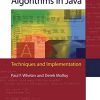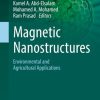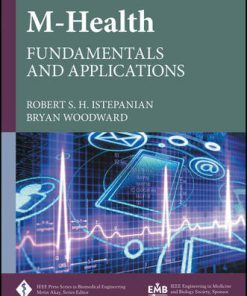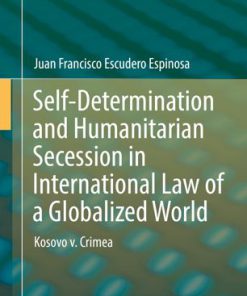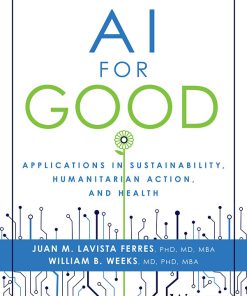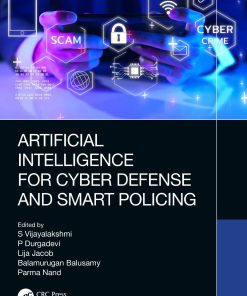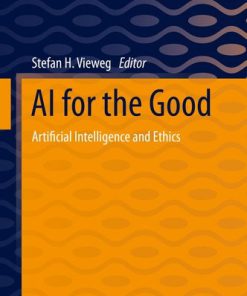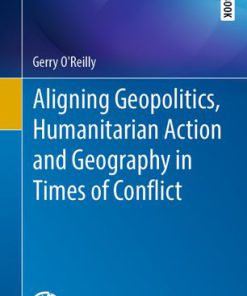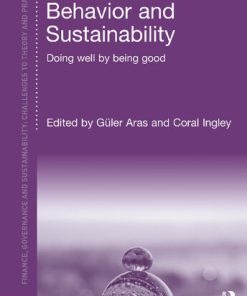AI for Good: Applications in Sustainability, Humanitarian Action, and Health 1st Edition Edited By Juan M. Lavista Ferres And William 1394235887 9781394235889
$50.00 Original price was: $50.00.$25.00Current price is: $25.00.
This completed downloadable of AI for Good: Applications in Sustainability, Humanitarian Action, and Health 1st Edition Edited By Juan M. Lavista Ferres And William B. Weeks
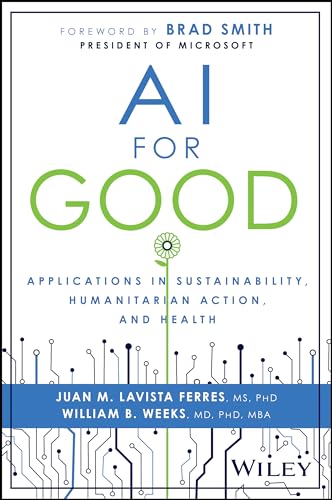
Instant downloaded AI for Good: Applications in Sustainability, Humanitarian Action, and Health 1st Edition Edited By Juan M. Lavista Ferres And William B. Weeks pdf docx epub after payment.
Product details:
- ISBN 10: 1394235887
- ISBN 13: 9781394235889
- Author: William B. Weeks
In AI for Good: Applications in Sustainability, Humanitarian Action, and Health, a team of veteran Microsoft AI researchers delivers an insightful and fascinating discussion of how one of the world’s most recognizable software companies is tackling intractable social problems with the power of artificial intelligence (AI). In the book, you’ll see real in-the-field examples of researchers using AI with replicable methods and reusable AI code to inspire your own uses.
Table of contents:
Chapter 1: What Is Artificial Intelligence and How Can It Be Used for Good?
What Is Artificial Intelligence?
What If Artificial Intelligence Were Used to Improve Societal Good?
Chapter 2: Artificial Intelligence: Its Application and Limitations
Why Now?
The Challenges and Lessons Learned from Using Artificial Intelligence
Large Language Models
Chapter 3: Commonly Used Processes and Terms
Common Processes
Commonly Used Measures
The Structure of the Book
Part II: Sustainability
Chapter 4: Deep Learning with Geospatial Data
Executive Summary
Why Is This Important?
Methods Used
Findings
Discussion
What We Learned
Chapter 5: Nature-Dependent Tourism
Executive Summary
Why Is This Important?
Methods Used
Findings
Discussion
What We Learned
Chapter 6: Wildlife Bioacoustics Detection
Executive Summary
Why Is This Important?
Methods Used
Findings
Discussion
What We Learned
Chapter 7: Using Satellites to Monitor Whales from Space
Executive Summary
Why Is This Important?
Methods Used
Findings
Discussion
What We Learned
Chapter 8: Social Networks of Giraffes
Executive Summary
Why Is This Important?
Methods Used
Findings
Discussion
What We Learned
Chapter 9: Data-driven Approaches to Wildlife Conflict Mitigation in the Maasai Mara
Executive Summary
Why Is This Important?
Methods Used
Findings
Discussion
What We Learned
Chapter 10: Mapping Industrial Poultry Operations at Scale
Executive Summary
Why Is This Important?
Methods Used
Findings
Discussion
What We Learned
Chapter 11: Identifying Solar Energy Locations in India
Executive Summary
Why Is This Important?
Methods Used
Findings
Discussion
What We Learned
Chapter 12: Mapping Glacial Lakes
Executive Summary
Why Is This Important?
Methods Used
Findings
Discussion
What We Learned
Chapter 13: Forecasting and Explaining Degradation of Solar Panels with AI
Executive Summary
Why Is This Important?
Methods Used
Findings
Discussion
What We Learned
Part III: Humanitarian Action
Chapter 14: Post-Disaster Building Damage Assessment
Executive Summary
Why Is This Important?
Methods Used
Findings
Discussion
What We Learned
Chapter 15: Dwelling Type Classification
Executive Summary
Why Is This Important?
Methods Used
Findings
Discussion
What We Learned
Chapter 16: Damage Assessment Following the 2023 Earthquake in Turkey
Executive Summary
Why Is This Important?
Methods Used
Findings
Discussion
What We Learned
Chapter 17: Food Security Analysis
Executive Summary
Why Is This Important?
Methods Used
Findings
Discussion
What We Learned
Chapter 18: BankNote-Net: Open Dataset for Assistive Universal Currency Recognition
Executive Summary
Why Is This Important?
Methods Used
Findings
Discussion
What We Learned
Chapter 19: Broadband Connectivity
Executive Summary
Why Is This Important?
Methods Used
Findings
Discussion
What We Learned
Chapter 20: Monitoring the Syrian War with Natural Language Processing
Executive Summary
Why Is This Important?
Methods Used
Findings
Discussion
What We Learned
Chapter 21: The Proliferation of Misinformation Online
Executive Summary
Why Is This Important?
Methods Used
Findings
Discussion
What We Learned
Chapter 22: Unlocking the Potential of AI with Open Data
Executive Summary
Why Is This Important?
Methods Used
Findings
Discussion
What We Learned
Part IV: Health
Chapter 23: Detecting Middle Ear Disease
Executive Summary
Why Is This Important?
Methods Used
Findings
Discussion
What We Learned
Chapter 24: Detecting Leprosy in Vulnerable Populations
Executive Summary
Why Is This Important?
Methods Used
Findings
Discussion
What We Learned
Chapter 25: Automated Segmentation of Prostate Cancer Metastases
Executive Summary
Why Is This Important?
Methods Used
Findings
Discussion
What We Learned
Chapter 26: Screening Premature Infants for Retinopathy of Prematurity in Low-Resource Settings
Executive Summary
Why Is This Important?
Methods Used
Findings
Discussion
What We Learned
Chapter 27: Long-Term Effects of COVID-19
Executive Summary
Why Is This Important?
Methods Used
Findings
Discussion
What We Learned
Chapter 28: Using Artificial Intelligence to Inform Pancreatic Cyst Management
Executive Summary
Why Is This Important?
Methods Used
Findings
Discussion
What We Learned
Chapter 29: NLP-Supported Chatbot for Cigarette Smoking Cessation
Executive Summary
Why Is This Important?
Methods Used
Findings
Discussion
What We Learned
Chapter 30: Mapping Population Movement Using Satellite Imagery
Executive Summary
Why Is This Important?
Methods Used
Findings
Discussion
What We Learned
Chapter 31: The Promise of AI and Generative Pre-Trained Transformer Models
People also search:
ai for good global summit
ai for good 2025
ai for good book
un ai for good summit
ai for good stanford
You may also like…
Cookbooks
Politics & Philosophy
Uncategorized
Computers - Artificial Intelligence (AI)
Computers - Computer Science
Politics & Philosophy
Aligning Geopolitics Humanitarian Action and Geography in Times of Conflict Gerry O’Reilly
Business & Economics - Management & Leadership
Corporate Behavior and Sustainability Doing Well by Being Good 1st Edition Güler Aras


